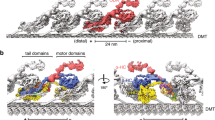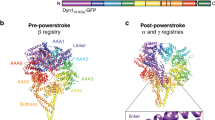Abstract
THE 'motor' proteins of eukaryotic cells contain specialized domains that hydrolyse ATP to produce force and movement along a cytoskeletal polymer (actin in the case of the myosin family; microtubules in the case of the kinesin family and dyneins). There are motor-protein superfamilies in which each member has a conserved force-generating domain joined to a different 'tail' which conveys specific attachment properties (see ref. 1 for a review). The minus-end-directed microtubule motors, the dyneins2, may also constitute a superfamily of force-generating proteins with distinct attachment domains3. Axonemal outer-arm dynein from sea urchin spermatozoa is a multimeric protein consisting of two heavy chains (α and β) with ATPase activity, three intermediate chains and several light chains4. Here I report the sequence of cloned complementary DNA encoding the β heavy chain of a dynein motor molecule. The predicted amino-acid sequence reveals four ATP-binding consensus sequences in the central domain. The dynein β heavy chain is thought to associate transiently with a microtubule during ATP hydrolysis5, but the ATP-dependent microtubule-binding sequence common to the kinesin superfamily is not found in the dynein β heavy chain. These unique features distinguish the dynein β heavy chain from other motor protein superfamilies and may be characteristic of the dynein superfamily.
This is a preview of subscription content, access via your institution
Access options
Subscribe to this journal
Receive 51 print issues and online access
$199.00 per year
only $3.90 per issue
Buy this article
- Purchase on Springer Link
- Instant access to full article PDF
Prices may be subject to local taxes which are calculated during checkout
Similar content being viewed by others
References
Vale, R. D. & Goldstein, L. S. B. Cell 60, 883–885 (1990).
Gibbons, I. R. J. Cell Biol. 91, 107s–124s (1981).
Ogawa, K. et al. Eur. J. Cell Biol. 43, 3–9 (1987).
Tang, W.-J. Y. et al. J. biol. Chem. 257, 508–515 (1982).
Sale, W. S. & Fox, L. A. J. Cell Biol. 107, 1793–1797 (1988).
Ogawa, K. et al. Cell Motil. Cytoskel. 16, 58–67 (1990).
Nishikawa, K. & Noguchi, T. Meth. Enzym. 202, 31–44 (1991).
Nishikawa, K. & Ooi, T. J. Biochem. 100, 1043–1046 (1986).
Ogawa, K. & Mohri, H. J. biol. Chem. 250, 6476–6483 (1975).
Ow, R. A. et al. J. biol. Chem. 262, 3409–3414 (1987).
Ogawa, K. Proc. Japan Acad. 67B, 27–31 (1991).
Sale, W. S. et al. J. Cell Biol. 101, 1400–1412 (1985).
Walker, J. E. et al. EMB0 J. 1, 945–951 (1982).
Gibbons, I. R. et al. J. biol. Chem. 262, 2780–2786 (1987).
Tang, W.-J. Y. & Gibbons, I. R. J. biol. Chem. 262, 17728–17734 (1987).
Pfister, K. K. et al. J. biol. Chem. 259, 8499–8504 (1984).
Lewis, S. L. et al. Science 242, 936–939 (1988).
Lee, G. et al. Science 239, 285–288 (1988).
Yang, J. T. et al. Cell 56, 879–889 (1989).
Kozak, M. Cell 44, 283–292 (1986).
Matsudaira, P. J. biol. Chem. 262, 10035–10038 (1987).
Author information
Authors and Affiliations
Rights and permissions
About this article
Cite this article
Ogawa, K. Four ATP-binding sites in the midregion of the β heavy chain of dynein. Nature 352, 643–645 (1991). https://doi.org/10.1038/352643a0
Received:
Accepted:
Issue Date:
DOI: https://doi.org/10.1038/352643a0
This article is cited by
-
Sperm dysfunction and ciliopathy
Reproductive Medicine and Biology (2016)
-
Cytoplasmic Dynein: Tension Generation on Microtubules and the Nucleus
Cellular and Molecular Bioengineering (2013)
-
Processive bidirectional motion of dynein–dynactin complexes in vitro
Nature Cell Biology (2006)
-
ATP hydrolysis cycle–dependent tail motions in cytoplasmic dynein
Nature Structural & Molecular Biology (2005)
-
Specific Features of Centriole Formation and Ciliogenesis in Ciliary Epithelium Cells of Respiratory Tracts in Patients with Kartagener Syndrome
Russian Journal of Developmental Biology (2005)
Comments
By submitting a comment you agree to abide by our Terms and Community Guidelines. If you find something abusive or that does not comply with our terms or guidelines please flag it as inappropriate.



